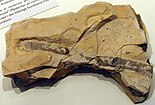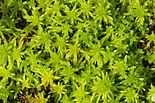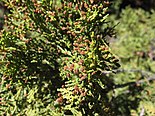| Precipice Sandstone | |
|---|---|
| Stratigraphic range: Sinemurian to early Pliensbachian ~199–187 Ma PreꞒ Ꞓ O S D C P T J K Pg N | |
 Mount Morgan Mine, where strata of the formation was exposed Mount Morgan Mine, where strata of the formation was exposed | |
| Type | Geological formation |
| Unit of | Bundamba Group |
| Sub-units |
|
| Underlies | Evergreen Formation |
| Overlies | |
| Thickness | 175 m (574 ft) |
| Lithology | |
| Primary | Sandstone |
| Other | Siltstone, mudstone |
| Location | |
| Coordinates | 24°18′S 150°30′E / 24.3°S 150.5°E / -24.3; 150.5 |
| Approximate paleocoordinates | 58°36′S 92°24′E / 58.6°S 92.4°E / -58.6; 92.4 |
| Region | |
| Country | |
| Extent | Surat Basin |
| Type section | |
| Named for | Sandstone cliffs in the gorge of Precipice Creek, a tributary of the Dawson River |
| Named by | Whitehouse |
 | |
The Precipice Sandstone an Early Jurassic (Sinemurian to early Pliensbachian, with possible Hettangian levels) geologic formation of the Surat Basin in New South Wales and Queensland, eastern Australia, know due to the presence of abundant vertebrate remains & tracks. This unit includes the previously described Razorback beds. This unit represents a major, almost primary, source of hydrocarbons in the region, with a Potential CO2 reservoir of up to 70m. It was deposited on top of older sediments, like Bowen Basin units, in an unconformable manner, resting along the eastern basin margin and the Back Creek Group in the southern Comet Platform, while in other areas it directly overlies the Triassic Moolayember Formation & Callide Coal Measures, being deposited in a comparatively stable basin. Isopach maps of the Precipice Sandstone indicate two distinct areas of sediment accumulation, suggesting two separate depocentres filled from different source regions during the Sinemurian, with the Thomson orogeny and New England Orogen hinterlands as possible ones. This unit represented a fluvial-palustrine-lacustrine braided channel north-flowing succession, that seem to have debouch into a shallow restricted tidal/wave influenced marine embayment, marked at areas like Woleebee Creek. Paleoenvironment-wise, it represents a hinterland rich in vegetation, hinting at wet environments like swamps, where agglutinated foraminifera suggests marine flooding and drier conditions or the encroachment of seawater onto coastal areas.
Fireclay Caverns

The Fireclay Caverns were excavated by the Mount Morgan Mine to provide clay for its brickworks resulting in very large openings that measure between 4–12 metres in height from the cave floor. Excavation of the caverns ceased when the mine brickworks were decommissioned in the early 1900s. Erosion revealed dinosaur footprints (preserved as infills) being discovered in 1954. To date, nine different ceiling sections of the Fireclay Caverns have been recognised as containing dinosaur footprints. These have been dated to the Early Jurassic (Sinemurian) ~195 million years ago. Walkways and stairs had been constructed in 2010 to provide access to the dinosaur footprints as part of the mine site tours. The site was closed to access in 2011 due to ceiling erosion posing a significant risk to public safety.
The Fireclay Caverns were excavated to supply clay to brickworks of the Mount Morgan Mine. Clay was mined from within the caverns by pick and shovel, then transferred by underground rail to a brickworks lower in the Mount Morgan Mine site. Excavation from the caverns ceased when their clay was no longer required by the mine. After cavern excavations ceased, clay progressively fell from the cavern ceilings, revealing rock ceilings above. In 1954, HRE Staines, a Mount Morgan Limited geologist, identified dinosaur footprints in the rock ceilings. Over 300 such footprints have been identified on the cavern ceilings dated to the Early Jurassic (Sinemurian) ~195 million years ago. 2024 represents the 70th anniversary of when Ross Staines published Australia's first dinosaur trackway-consisting of four footprints. To celebrate, previously unpublished archival photographs (c. 1954) enabled a re-examination of Staines' original trackway, from which two additional footprints were revealed. Analyses indicated the trackmaker exhibited a walking gait, initially walking at ~3.8 km/h and then slowed to 1.8 km/h in association with a slight turn in direction.
After cavern excavations ceased, a colony of bent-wing bats began inhabiting the caverns. The sections of the caverns containing the bats are inaccessible to protect the bat habitat.
Biota
Invertebrates
| Genus | Species | Type | Location | Material | Origin | Notes | Images |
|---|---|---|---|---|---|---|---|
| Asterosoma |
|
Fodinichnia |
|
Radiating bulb-like swelling burrows | Annelid worm, vermiform organism | Freshwater/Blackish burrow-like ichnofossils | |
| Conichnus |
|
|
trails | Gastropods | Freshwater/Blackish fillings-like ichnofossils | ||
| Cylindrichnus |
|
|
Long, subconical, weakly curved burrows |
|
Freshwater/Blackish burrow-like ichnofossils | ||
| Diplocraterion |
|
Domichnia | U-shaped burrows |
|
Marine-Mangroove Vertical, U-shaped, single-spreite Burrows; unidirectional or bidirectional spreite, generally continuous, rarely discontinuous. Most Diplocraterion show only protrusive spreiten, like the local ones, produced under predominantly erosive conditions where the organism was constantly burrowing deeper into the substrate as sediment was eroded from the top. |  | |
| Helminthopsis |
|
Fodinichnia | Simple, unbranched, horizontal cylinder traces | Saltwater/Blackish burrow-like ichnofossils. |  | ||
| Lockeia |
|
|
Dwelling traces |
|
Marine, brackish or freshwater resting traces of Bivalves. |  | |
| Naktodemasis |
|
Fodinichnia | Straight to sinuous, unlined and unbranched burrows |
|
Freshwater/Terrestrial burrow-like ichnofossils. | ||
| Palaeophycus |
|
Domichnia | Straight or gently curved tubular burrows. |
|
Freshwater/Blackish burrow-like ichnofossils. |  | |
| Phycosiphon |
|
Fodinichnia | Irregularly meandering burrows | Vermiform Animals | Freshwater burrow-like ichnofossils. | ||
| Planolites |
|
Pascichnia | Cylindrical or elliptical curved/tortuous trace fossils |
|
Freshwater/Blackish burrow-like ichnofossils. Planolites is really common in all types of the Ciechocinek Formation deposits. It is referred to vermiform deposit-feeders, mainly Polychaetes, producing active Fodinichnia. It is controversial, since is considered a strictly a junior synonym of Palaeophycus. |  | |
| Scolicia |
|
|
Symmetrical trail or burrow | Gastropods | Freshwater/Blackish trail-like ichnofossils |  | |
| Skolithos |
|
Domichnia | Cylindrical strands with branches |
|
Blackish trace ichnofossils. Interpreted as dwelling structures of vermiform animals, more concretely the Domichnion of a suspension-feeding Worm or Phoronidan. | ||
| Siphonichnus |
|
Domichnia | Cylindrical strands with branches |
|
Blackish trace ichnofossils. Interpreted as dwelling structures of vermiform animals, more concretely the Domichnion of a suspension-feeding Worm or Phoronidan. | ||
| Taenidium |
|
Fodinichnia | Unlined meniscate burrows |
|
Freshwater/Blackish burrow-like ichnofossils. Taenidium is a meniscate backfill structure, usually considered to be produced by an animal progressing axially through the sediment and depositing alternating packets of differently constituted sediment behind it as it moves forward. | ||
| Thalassinoides |
|
Tubular Fodinichnia | Tubular Burrows |
|
Burrow-like ichnofossils. Large burrow-systems consisting of smooth-walled, essentially cylindrical components. Common sedimentary features are Thalassinoides trace fossils in the fissile marlstone to claystone intervals |  | |
| Teichichnus |
|
Fodinichnia | Vertical to oblique, unbranched or branched, elongated to arcuate spreite burrow |
|
Saltwater/Blackish burrow-like ichnofossils. The overall morphology and details of the burrows, in comparison with modern analogues and neoichnological experiments, suggest Echiurans (spoon worms) or Holothurians (sea cucumbers) with a combined suspension- and deposit-feeding behaviour as potential producers. |  |
Vertebrata
| Genus | Species | Location | Stratigraphic position | Material | Notes | Images |
|---|---|---|---|---|---|---|
|
Indeterminate |
|
Lower Member |
Footprints |
ornithischian footprints, unassigned to any concrete ichnogenus, but with resemblance with Anomoepodidae |
 | |
|
|
Lower Member |
Footprints |
Ornithischian Footprints, originally suggested as quadrupedal theropod tracks, latter identified as of Ornithischian origin. Up to 130 tracks & 4 short trackways are know. |
||
|
E. isp. |
Fireclay Caverns |
Lower Member |
Footprints |
Medium-sized Theropod Footprints. Currently represent the largest of the prints at Mount Morgan |
||
|
G. isp. |
Fireclay Caverns |
Lower Member |
Footprints |
Small-sized Theropod Footprints |
||
| Plesiosauria |
Indeterminate |
|
Razorback Beds |
|
A Freshwater Plesiosaur that cannot be confidently attributed to any particular plesiosaurian clade |
|
|
Indeterminate |
|
Lower Member |
Footprints |
Possible theropod footprints, unassigned to any concrete ichnogenus. One morphotype includes large tridactyl prints, up to 24 cm. |
 | |
|
"Indet. 2" |
Fireclay Caverns | |||||
|
"Indet. 3" |
Fireclay Caverns | |||||
|
W. isp. |
Fireclay Caverns |
Lower Member |
Footprints |
Small-sized Ornithischian Footprints |
Bryophyta
| Genus | Species | Stratigraphic position | Material | Notes | Images |
|---|---|---|---|---|---|
|
|
|
Incertae sedis; affinities with Bryophyta. |
||
|
Incertae sedis; affinities with Bryophyta. |
||||
|
Affinities with the family Sphagnaceae in the Sphagnopsida. |
||||
|
Affinities with the family Notothyladaceae in the Anthocerotopsida. |
||||
|
Incertae sedis; affinities with Bryophyta. This spore is found in Jurassic sediments associated with the polar regions. |
||||
|
Affinities with the family Notothyladaceae in the Anthocerotopsida. Hornwort spores. |
 | |||
|
Affinities with the family Sphagnaceae in the Sphagnopsida. "Peat moss" spores, related to genera such as Sphagnum that can store large amounts of water. |
 |
Lycophyta
| Genus | Species | Stratigraphic position | Material | Notes | Images |
|---|---|---|---|---|---|
|
|
|
Incertae sedis; affinities with Lycopodiopsida |
||
|
Affinities with the family Lycopodiaceae in the Lycopodiopsida. Lycopod spores, related to herbaceous to arbustive flora common in humid environments. |
 | |||
|
Affinities with the Selaginellaceae in the Lycopsida. |
Pteridophyta
| Genus | Species | Stratigraphic position | Material | Notes | Images |
|---|---|---|---|---|---|
|
|
|
Affinities with the Calamitaceae in the Equisetales. Horsetails are herbaceous flora found in humid environments and are flooding-tolerant. In the sections of the formation such as Korsodde, this genus has small peaks in abundance in the layers where more Equisetites stems are found. |
 |
Pteridophyta
| Genus | Species | Stratigraphic position | Material | Notes | Images |
|---|---|---|---|---|---|
|
|
|
Affinities with the genus Saccoloma, type representative of the family Saccolomataceae. This fern spore resembles those of the living genus Saccoloma, being probably from a pantropical genus found in wet, shaded forest areas. |
 | |
|
Affinities with the family Osmundaceae in the Polypodiopsida. Near fluvial current ferns, related to the modern Osmunda regalis. |
 | |||
|
Incertae sedis; affinities with the Pteridophyta |
||||
|
Affinities with the family Cyatheaceae in the Cyatheales. Arboreal fern spores. |
 | |||
|
Incertae sedis; affinities with the Pteridophyta |
||||
|
Affinities with the family Matoniaceae in the Gleicheniales. |
||||
|
Incertae sedis; affinities with the Pteridophyta |
||||
|
Incertae sedis; affinities with the Pteridophyta |
||||
|
Incertae sedis; affinities with the Pteridophyta |
||||
|
Incertae sedis; affinities with the Pteridophyta |
||||
|
Incertae sedis; affinities with the Pteridophyta |
||||
|
Affinities with the family Osmundaceae in the Polypodiopsida. Near fluvial current ferns, related to the modern Osmunda regalis. |
||||
|
Affinities with the family Osmundaceae in the Polypodiopsida. Near fluvial current ferns, related to the modern Osmunda regalis. |
Peltaspermales
| Genus | Species | Stratigraphic position | Material | Notes | Images |
|---|---|---|---|---|---|
|
|
|
Affinities with the families Peltaspermaceae, Corystospermaceae or Umkomasiaceae in the Peltaspermales. Pollen of uncertain provenance that can be derived from any of the members of the Peltaspermales. The lack of distinctive characters and poor conservation make this pollen difficult to classify. Arboreal to arbustive seed ferns. |
||
|
From the family Caytoniaceae in the Caytoniales. Caytoniaceae are a complex group of Mesozoic fossil floras that may be related to both Peltaspermales and Ginkgoaceae. |
Conifers
| Genus | Species | Stratigraphic position | Material | Notes | Images |
|---|---|---|---|---|---|
|
|
|
Affinities with the Hirmeriellaceae in the Pinopsida. |
||
|
Affinities with the family Cupressaceae in the Pinopsida. Pollen that resembles that of extant genera such as the genus Actinostrobus and Austrocedrus, probably derived from dry environments. |
 | |||
|
Affinities with the family Podocarpaceae. Pollen from diverse types of Podocarpaceous conifers, that include morphotypes similar to the low arbustive Microcachrys and the medium arbustive Lepidothamnus, likely linked with Upland settings |
 |
See also
References
- ^ Vickers-Rich, Patricia (1991). Vertebrate palaeontology of Australasia. Lilydale, Vic: Pioneer Design Studio in cooperation with the Monash University Publications Committee, Melbourne. doi:10.5962/bhl.title.60647. ISBN 0-909674-36-1.
- "Precipice Sandstone". Australian Stratigraphic Units Database. Geoscience Australia. Retrieved 6 December 2015.
- ^ Exon, N.F. (1976). "Geology of the Surat Basin in Queensland" (PDF). Bureau of Mineral Resources, Australia. Bulletin. 166 (2): 1–235.
- Murray, C.G.; Blake, P.R.; Crouch, S.B.S.; Hayward, M.A.; Robertson, A.D.C.; Simpson, G.A. (2012). "Geology of the Yarrol Province central coastal Queensland". Queensland Geology. 13 (1): 1–675.
- Farquhar, S. M.; Dawson, G. K. W.; Esterle, J. S.; Golding, S. D. (2013-02-01). "Mineralogical characterisation of a potential reservoir system for CO2 sequestration in the Surat Basin". Australian Journal of Earth Sciences. 60 (1): 91–110. Bibcode:2013AuJES..60...91F. doi:10.1080/08120099.2012.752406. ISSN 0812-0099.
- Sobczak, Kasia; La Croix, Andrew D.; Esterle, Joan; Hayes, Phil; Holl, Heinz-Gerd; Ciesiolka, Rachael; Crowley, James L.; Allen, Charlotte M. (2022). "Geochronology and sediment provenance of the Precipice Sandstone and Evergreen Formation in the Surat Basin, Australia: Implications for the palaeo-geography of eastern Gondwana". Gondwana Research. 111: 189–208. Bibcode:2022GondR.111..189S. doi:10.1016/j.gr.2022.08.003. ISSN 1342-937X.
- Bianchi, V.; Zhou, F.; Pistellato, D.; Martin, M.; Boccardo, S.; Esterle, J. (2018-04-26). "Mapping a coastal transition in braided systems: an example from the Precipice Sandstone, Surat Basin". Australian Journal of Earth Sciences. 65 (4): 483–502. Bibcode:2018AuJES..65..483B. doi:10.1080/08120099.2018.1455156. ISSN 0812-0099.
- Martin, M.; Wakefield, M.; Bianchi, V.; Esterle, J.; Zhou, F. (2017-12-11). "Evidence for marine influence in the Lower Jurassic Precipice Sandstone, Surat Basin, eastern Australia". Australian Journal of Earth Sciences. 65 (1): 75–91. doi:10.1080/08120099.2018.1402821. ISSN 0812-0099.
- ^ Romilio, Anthony; Dick, Roslyn; Skinner, Heather; Millar, Janice (2020-02-13). "Archival data provides insights into the ambiguous track-maker gait from the Lower Jurassic (Sinemurian) Razorback beds, Queensland, Australia: evidence of theropod quadrupedalism?". Historical Biology. 33 (9): 1573–1579. doi:10.1080/08912963.2020.1720014. ISSN 0891-2963.
- ^ Staines, HRE (1954). "Dinosaur footprints at Mount Morgan". Queensland Government Mining Journal. 55 (623): 483–485.
- "Queensland Government: Mines and Energy: Mount Morgan Mine Site Quarterly Update: April-June 2010" (PDF). Archived from the original (PDF) on 6 July 2011. Retrieved 9 January 2011.
- "Queensland Government: Mines and Energy: Mount Morgan Mine Rehabilitation Project: Project Summary" (PDF). Archived from the original (PDF) on 12 March 2011. Retrieved 9 January 2011.
- Saini, N (2005). Geology and palaeo-ichnology of the Razorback beds, Mount Morgan, Queensland . University of Wollongong.
- ^ Romilio, Anthony (2020-04-20). "Additional notes on the Mount Morgan dinosaur tracks from the Lower Jurassic (Sinemurian) Razorback beds, Queensland, Australia". Historical Biology. 33 (10): 2005–2007. doi:10.1080/08912963.2020.1755853. ISSN 0891-2963. S2CID 218778298.
- ^ Romilio, Anthony; Dick, Roslyn; Skinner, Heather; Millar, Janice (2024-02-21). "Uncovering hidden footprints: revision of the Lower Jurassic (Sinemurian) Razorback Beds – home to Australia's earliest reported dinosaur trackway". Historical Biology: 1–8. doi:10.1080/08912963.2024.2320184. ISSN 0891-2963.
- ^ La Croix, A. D.; Wang, J.; He, J.; Hannaford, C.; Bianchi, V.; Esterle, J.; Undershultz, J. R. (2019). "Widespread nearshore and shallow marine deposition within the Lower Jurassic Precipice Sandstone and Evergreen Formation in the Surat Basin, Australia". Marine and Petroleum Geology. 109 (3): 760–790. Bibcode:2019MarPG.109..760L. doi:10.1016/j.marpetgeo.2019.06.048. hdl:10289/12877. Retrieved 30 May 2023.
- Romilio, Anthony (2020-11-12). "Evidence of ornithischian activity from the Lower Jurassic (Hettangian–Sinemurian) Precipice Sandstone, Callide Basin, Queensland, Australia — preliminary findings". Historical Biology. 33 (11): 3041–3045. doi:10.1080/08912963.2020.1846033. ISSN 0891-2963.
- Thulborn, Richard A. (1994). "Ornithopod dinosaur tracks from the Lower Jurassic of Queensland". Alcheringa: An Australasian Journal of Palaeontology. 18 (3): 247–258. Bibcode:1994Alch...18..247T. doi:10.1080/03115519408619498. ISSN 0311-5518.
- Romilio, Anthony; Dick, Roslyn; Skinner, Heather; Millar, Janice (2020-02-13). "Archival data provides insights into the ambiguous track-maker gait from the Lower Jurassic (Sinemurian) Razorback beds, Queensland, Australia: evidence of theropod quadrupedalism?". Historical Biology. 33 (9): 1573–1579. doi:10.1080/08912963.2020.1720014. ISSN 0891-2963.
- ^ Cook, A. G.; Saini, N.; Hocknull, S. A. (2010). "Dinosaur footprints from the lower Jurassic of Mount Morgan, Queensland". Memoirs of the Queensland Museum-Nature. 55 (1): 135–146.
- Kear, B. P. (2012). "A revision of Australia's Jurassic plesiosaurs". Palaeontology. 55 (5): 1125–1138. Bibcode:2012Palgy..55.1125K. doi:10.1111/j.1475-4983.2012.01183.x. Retrieved 30 May 2023.
- Molnar, R. E. (1980). "Australian late Mesozoic continental tetrapods: some implications". Mémoires de la Société Géologique de France, Nouvelle Série. 139 (5): 131–143.
- ^ Playford, G.; Cornelius, Kenneth D. (1967). "Palynological and lithostratigraphic features of the Razorback Beds, Mount Morgan District, Queensland". Papers Department of Geology, University of Queensland: 81–94.